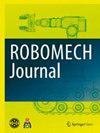检测漏水和燃料碎片的机器人系统的研究视觉里程计提供直观鸟瞰图的系统建议和可行性研究-
IF 1.7
Q3 INSTRUMENTS & INSTRUMENTATION
引用次数: 2
摘要
为了获取福岛第一核电站退役过程中燃料碎片和水泄漏的必要信息,提出了一种基于超声的主安全壳内部调查方法。在本文中,我们描述了旋转绞车机构和视觉定位方法,这是用来帮助调查。我们使用可旋转的绞车机构来调整超声波传感器的高度和方向,并使用摄像头对机器人进行定位,以定位传感器,为数据组合提供辅助信息。研究了传统视觉里程法应用于该场景的可行性,并利用移动机器人平台原型进行了定位精度评估实验。结果表明,视觉里程计方法能够生成直观的鸟瞰图,平均错误率为35 mm/1500 mm,满足光栅运动的最大错误率100 mm/1500 mm的要求。实验还进行了可调的参数范围,可以提供所需的精度。本文章由计算机程序翻译,如有差异,请以英文原文为准。
Study of a robotic system to detect water leakage and fuel debris-System proposal and feasibility study of visual odometry providing intuitive bird’s eye view-
To obtain the necessary information on fuel debris and water leakages during the decommissioning task of the Fukushima Daiichi Nuclear Power Plant, an ultrasonic-based method was proposed for future internal investigation of the primary containment vessel (PCV). In this article, we describe the rotatable winch mechanism and visual localization method, which were used to aid the investigation. We used the rotatable winch mechanism to adjust the height and orientation of the ultrasonic sensor and localized the robot with cameras to localize the sensor, to provide assisting information for data combination. We studied the feasibility of the conventional visual odometry method for application to the situation and performed localizing accuracy evaluation experiments with a mobile robotic platform prototype. The results showed that the visual odometry method could generate intuitive bird’s-eye-view maps, and provided an average error rate of 35 mm/1500 mm, which met the required maximum error rate of 100 mm/1500 mm for the grating movement. Experiments were also conducted with adjustable parameter ranges that could provide the required accuracy.
求助全文
通过发布文献求助,成功后即可免费获取论文全文。
去求助
来源期刊

ROBOMECH Journal
Mathematics-Control and Optimization
CiteScore
3.20
自引率
7.10%
发文量
21
审稿时长
13 weeks
期刊介绍:
ROBOMECH Journal focuses on advanced technologies and practical applications in the field of Robotics and Mechatronics. This field is driven by the steadily growing research, development and consumer demand for robots and systems. Advanced robots have been working in medical and hazardous environments, such as space and the deep sea as well as in the manufacturing environment. The scope of the journal includes but is not limited to: 1. Modeling and design 2. System integration 3. Actuators and sensors 4. Intelligent control 5. Artificial intelligence 6. Machine learning 7. Robotics 8. Manufacturing 9. Motion control 10. Vibration and noise control 11. Micro/nano devices and optoelectronics systems 12. Automotive systems 13. Applications for extreme and/or hazardous environments 14. Other applications
 求助内容:
求助内容: 应助结果提醒方式:
应助结果提醒方式:


